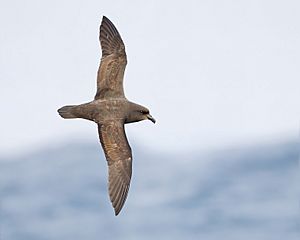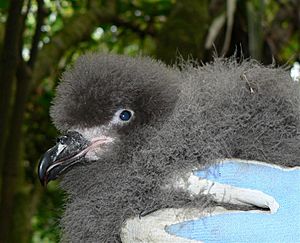Great-winged petrel facts for kids
Quick facts for kids Great-winged petrel |
|
|---|---|
 |
|
| Conservation status | |
| Scientific classification | |
| Genus: |
Pterodroma
|
| Species: |
macroptera
|
The great-winged petrel (Pterodroma macroptera) is a type of petrel, which is a seabird. It spends most of its life flying over the ocean.
Contents
What is a Great-winged Petrel?
This bird was once thought to have two different types, called subspecies. One type, P. m. macroptera, is the great-winged petrel we know today. The other type, P. m. gouldi, lived only in New Zealand.
However, scientists later found that the New Zealand bird was different enough to be its own species. So, since 2014, it is now known as the grey-faced petrel (Pterodroma gouldi).
What Does It Look Like?
The great-winged petrel is a large seabird. It grows to be about 42 to 45 centimeters (about 16 to 18 inches) long. Its feathers are completely dark brown. The only lighter part is a small white patch near the bottom of its bill. Its bill is black and looks thick and strong.
It can be tricky to tell this bird apart from other similar seabirds. For example, the sooty shearwater and short-tailed shearwater look a bit alike. But the great-winged petrel has dark feathers under its wings. It also has a different way of flying and a thicker bill. Another bird, the flesh-footed shearwater, has a light, pinkish bill, which helps tell it apart.
Where Do Great-winged Petrels Live?
Great-winged petrels make their nests and raise their young in the Southern Hemisphere. This is the part of the world south of the equator. They breed in areas between 30 and 50 degrees south latitude.
You can find their nesting places, called colonies, on several islands. These include Tristan da Cunha, Gough Island, the Crozet Islands, the Prince Edward Islands, and the Kerguelen Islands. They also breed along the coasts of southern Australia. Sometimes, a great-winged petrel might fly far from its usual home. It has been seen as a rare visitor, or "vagrant," off the coast of California in the United States.
Diet and Life Cycle
Great-winged petrels mostly eat squid. They also eat some fish and small sea creatures called crustaceans. They usually catch their food at night. They do this by dipping their heads into the water or grabbing prey from the surface.
Sometimes, these petrels will follow whales to find food. They might also feed alongside other types of seabirds.
Their breeding season happens in the southern winter, starting around April. They build their nests either alone or in small groups. They make their nests in burrows in the ground. They can also nest above ground among rocks or low plants.
See also
 In Spanish: Pardela de alas grandes para niños
In Spanish: Pardela de alas grandes para niños




